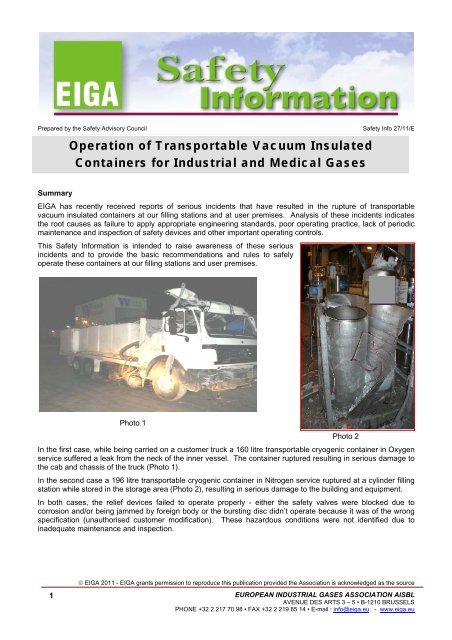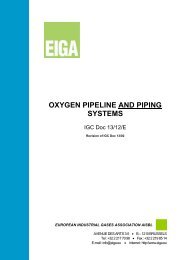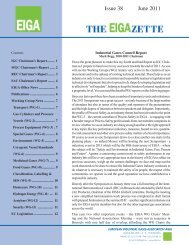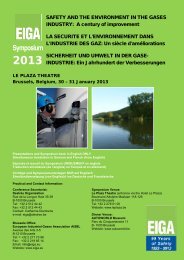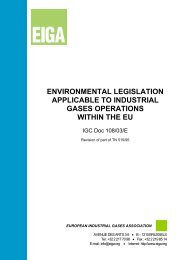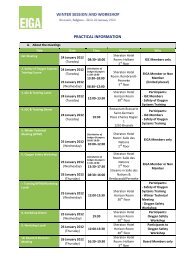download - eiga
download - eiga
download - eiga
Create successful ePaper yourself
Turn your PDF publications into a flip-book with our unique Google optimized e-Paper software.
Prepared by the Safety Advisory Council Safety Info 27/11/E<br />
1<br />
Operation of Transportable Vacuum Insulated<br />
Containers for Industrial and Medical Gases<br />
Summary<br />
EIGA has recently received reports of serious incidents that have resulted in the rupture of transportable<br />
vacuum insulated containers at our filling stations and at user premises. Analysis of these incidents indicates<br />
the root causes as failure to apply appropriate engineering standards, poor operating practice, lack of periodic<br />
maintenance and inspection of safety devices and other important operating controls.<br />
This Safety Information is intended to raise awareness of these serious<br />
incidents and to provide the basic recommendations and rules to safely<br />
operate these containers at our filling stations and user premises.<br />
Photo 1<br />
Photo 2<br />
In the first case, while being carried on a customer truck a 160 litre transportable cryogenic container in Oxygen<br />
service suffered a leak from the neck of the inner vessel. The container ruptured resulting in serious damage to<br />
the cab and chassis of the truck (Photo 1).<br />
In the second case a 196 litre transportable cryogenic container in Nitrogen service ruptured at a cylinder filling<br />
station while stored in the storage area (Photo 2), resulting in serious damage to the building and equipment.<br />
In both cases, the relief devices failed to operate properly - either the safety valves were blocked due to<br />
corrosion and/or being jammed by foreign body or the bursting disc didn’t operate because it was of the wrong<br />
specification (unauthorised customer modification). These hazardous conditions were not identified due to<br />
inadequate maintenance and inspection.<br />
� EIGA 2011 - EIGA grants permission to reproduce this publication provided the Association is acknowledged as the source<br />
EUROPEAN INDUSTRIAL GASES ASSOCIATION AISBL<br />
AVENUE DES ARTS 3 – 5 • B-1210 BRUSSELS<br />
PHONE +32 2 217 70 98 • FAX +32 2 219 85 14 • E-mail : info@<strong>eiga</strong>.eu - www.<strong>eiga</strong>.eu
A transportable vacuum insulated container<br />
Typical container size in the industry varies from 100 to 1,000 litre water capacity. It is<br />
estimated that there are more than 1,000,000 of these containers in use worldwide.<br />
Typical design and safety features are shown in this example (photo 3):<br />
2<br />
Safety Info 27/11/E – Page 2<br />
Capacity: 196 litre water capacity giving circa 180 litres of liquid Nitrogen<br />
Insulation: Vacuum insulated.<br />
Working pressure: Nominal max. pressure 15.9 barg.<br />
Test pressure: 22 barg.<br />
Trycock: Set for filling to 95% capacity.<br />
Safety devices: Dual safety relief valves or safety relief valve and bursting disc<br />
Photo 3<br />
These containers are designed for liquid and gas withdrawal. They are fitted with a regulated pressure raising<br />
circuit and equipped with a pressure gauge and a level indicator.<br />
Known risks<br />
� Non standard couplings on the liquid or gas connections or unauthorized modifications to these couplings<br />
� Safety devices such as the pressure relief valve(s) and/or bursting disc not being maintained or inspected<br />
� Unauthorised design modification to fulfil individual customer requirements<br />
� Unauthorised modifications carried out by the customer<br />
� Containers are frequently rented out to a third party (customer) where the responsibility for periodic<br />
inspection and maintenance is unclear<br />
� Transfilling operations from large vessels to these smaller containers done by non competent personnel<br />
� Container contamination at customer premises<br />
� No reporting to the owner of damage that has occurred on rented vessel at customer premises or during<br />
transport<br />
Recommendations for safe operation<br />
Requirements for the design, use and handling of this equipment are defined in the European Standard EN<br />
1251-1/2/3 “Cryogenic vessels — Transportable vacuum insulated vessels of not more than 1000 litres volume”.<br />
Gas Companies and customers have certain duties to ensure that these containers comply with these<br />
requirements.<br />
Key requirements include the following.<br />
� Only containers that comply with the relevant regulations and legislation e.g. ADR (if the containers are<br />
transported full) and TPED shall be used in the European Union countries. New containers may be PI or<br />
CE marked.<br />
� Pre-fill check procedures shall be implemented wherever the containers are filled. These procedures<br />
shall be carried out by a trained and competent operator and in order to check as a minimum the date of<br />
the last inspection, product and withdrawal instruction labels, general condition, operation of manual<br />
valves, protective devices, outlet connection(s), pressure gauge and level indicator.<br />
o The check of the protective devices, safety valve(s),bursting disc(s) should include checking for<br />
external damage, and ensuring the outlet is not plugged or restricted, if the safety valve is fitted<br />
with a lever this may be used to prove the safety valve is operational,<br />
� In the case of filling by weight, maximum permissible filling weights shall be observed<br />
� Pressure relief devices shall be changed or tested at intervals in accordance with the technical<br />
specification of the manufacturer and at a period not exceeding five years. The pressure relief device<br />
shall only be changed or tested by an appointed competent person such as an EIGA company<br />
employee who has been trained to carry out the task. Test results shall be documented.<br />
� EIGA 2011 - EIGA grants permission to reproduce this publication provided the Association is acknowledged as the source<br />
EUROPEAN INDUSTRIAL GASES ASSOCIATION AISBL<br />
AVENUE DES ARTS 3 – 5 � B-1210 BRUSSELS<br />
PHONE +32 2 217 70 98 • FAX +32 2 219 85 14 • E-mail : info@<strong>eiga</strong>.eu - www.<strong>eiga</strong>.eu
3<br />
Safety Info 27/11/E – Page 3<br />
� At intervals not exceeding 10 years a periodic inspection shall include an external visual inspection, leak<br />
test and vacuum check which shall be carried out by an appointed competent person.<br />
� The owner of the container shall retain records of any periodic inspections, repairs or modification and<br />
any corrective actions.<br />
� Manufacturer’s original sized and fitted safety devices shall not be modified or replaced unless there<br />
has been a management of change (engineering modification) procedure applied.<br />
References<br />
EIGA IGC Doc. 93 Safety Features of Portable Cryogenic Liquid Containers for Industrial and Medical Gases.<br />
BCGA CP27 Transportable Vacuum Insulated Containers of not more than 1000 litre volume. Revision 1:2004<br />
EN 1251-1/2/3 Cryogenic vessels – Transportable vacuum insulated vessels of not more than 1000 litres.<br />
European Agreement concerning the International Carriage of Dangerous Goods by Road (ADR).<br />
DISCLAIMER<br />
All technical publications of EIGA or under EIGA’s name, including Codes of practice, Safety procedures and any other technical information contained in<br />
such publications were obtained from sources believed to be reliable and are based on technical information and experience currently available from<br />
members of EIGA and others at the date of their issuance.<br />
While EIGA recommends reference to or use of its publications by its members, such reference to or use of EIGA’s publications by its members or third<br />
parties are purely voluntary and not binding. Therefore, EIGA or its members make no guarantee of the results and assume no liability or responsibility in<br />
connection with the reference to or use of information or suggestions contained in EIGA’s publications.<br />
EIGA has no control whatsoever as regards, performance or non performance, misinterpretation, proper or improper use of any information or suggestions<br />
contained in EIGA’s publications by any person or entity (including EIGA members) and EIGA expressly disclaims any liability in connection thereto.<br />
EIGA’s publications are subject to periodic review and users are cautioned to obtain the latest edition.<br />
� EIGA 2011 - EIGA grants permission to reproduce this publication provided the Association is acknowledged as the source<br />
EUROPEAN INDUSTRIAL GASES ASSOCIATION AISBL<br />
AVENUE DES ARTS 3 – 5 � B-1210 BRUSSELS<br />
PHONE +32 2 217 70 98 • FAX +32 2 219 85 14 • E-mail : info@<strong>eiga</strong>.eu - www.<strong>eiga</strong>.eu


